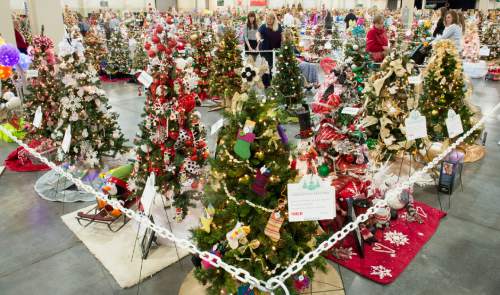This is an archived article that was published on sltrib.com in 2014, and information in the article may be outdated. It is provided only for personal research purposes and may not be reprinted.
No skirt, no service at the Festival of Trees.
A Skyline High School senior was blocked from volunteering at the annual Christmas tree show Saturday because her pantsuit was determined to be a violation of the event's dress code.
Ellie Kaiser said she arrived at the South Towne Expo Center for a service project organized by her school's National Honor Society. She was dressed professionally in slacks and a jacket, she said, but was told that pants are not allowed for female volunteers.
"I just never really imagined that it would be that big of a problem," Kaiser said.
The annual fundraiser for Primary Children's Hospital enforces a strict dress code for its volunteers, festival chairwoman Marie Partridge said Monday.
Volunteers are expected to stand out from the crowd so visitors know whom to turn to for questions, Partridge said. That means a dress shirt, tie and slacks for men, and a skirt or dress for women.
"Once someone sees someone wearing pants, then everyone thinks that would be accepted," she said. "We just don't go there. We still are very strict in the way we want Primary Children's Hospital represented."
Each year at the festival, hundreds of themed Christmas trees are auctioned off to buyers. Many are lovingly crafted and donated by the family and friends of current or former Primary Children's patients and can sell for up to $25,000. But the fundraiser also includes smaller items for sale, including wreaths and gingerbread houses.
Last year, the event raised roughly $1.8 million for the medical center.
When volunteers arrive dressed in clothing that doesn't comply with the dress code, Partridge said, organizers try to find work for them off of the festival floor and away from the public eye. But those positions are limited and often are fully staffed, she said, leaving little to do for someone who is dressed inappropriately.
"We do need lots of volunteers," she said. "We try never to turn anyone away. But we do adhere strictly to our dress code."
Kaiser said she was informed of the dress code, but she assumed the directive to wear a skirt or dress was because few of her high school-aged peers own pantsuits.
Organizers offered Kaiser the opportunity to change into an extra skirt at the festival office or to help with the event's coat check, she said. Instead, she elected to leave the event.
"I didn't feel comfortable," she said. "You can go and hide in the back where people won't see you, but you can't be out there talking to people because what you're wearing is wrong."
The Festival of Trees, like Primary Children's Hospital, has its roots in The Church of Jesus Christ of Latter-day Saints. According to the Festival of Trees website, a group of women was challenged by the hospital's Men's Endowment Board to find a way to raise funds, which led to the creation of the Women's Endowment Committee and the annual festival nearly 50 years ago.
The hospital now is owned by Intermountain Healthcare.
The festival is independently organized by a volunteer board of 89 women who each lead a committee of 10 individuals, most of whom are female, said Sharon Goodrich, foundation director for Primary Children's.
"These women literally work all year long," Goodrich said. "It's always Christmas. They never stop working for these kids."
Goodrich said the dress code helps volunteers appear official when assisting the roughly 100,000 visitors who attend the four-day event each year.
"You don't see a lot of women wearing dresses or skirts these days," she said. "But in that crowd, you know if a woman is wearing a skirt or a dress, or if a man is wearing a tie, they're probably in a position of authority."
The dress code, Goodrich said, offers clarity to volunteers, because one person's definition of appropriate dress might conflict with the attitudes of event organizers. She said the success of the event is dependent on volunteers and the dress code is not intended to be punitive.
"I trust these women who are in charge and are establishing these kinds of guidelines," she said.
But Kaiser said she was brokenhearted that she couldn't volunteer at the event. She said the dress code is sexist, punishing her for wearing nice slacks because she is a woman.
"It would be so easy for them to just change this policy and nobody would really be hurt by it," she said. "You can still dress professionally and modestly in pants."
Kaiser did not know of any other student volunteers who were turned away because of the dress code policy. But she said her friends at school have been supportive after hearing her story.
If the dress code policy isn't changed, Kaiser said, she would continue to support Primary Children's Hospital, but would not support the Festival of Trees in the future.
"I can still volunteer there on my own," she said, "and I wouldn't have to go through this organization that I believe has very discriminatory policies."
For its part, Primary Children's Hospital does not require female employees to wear skirts.
Spokeswoman Bonnie Midget said the hospital's internal dress policy instructs staff only to dress appropriately for work and does not place any restrictions on a woman choosing to dress in slacks or a pantsuit.
"It's really very gender-neutral," Midget said.





